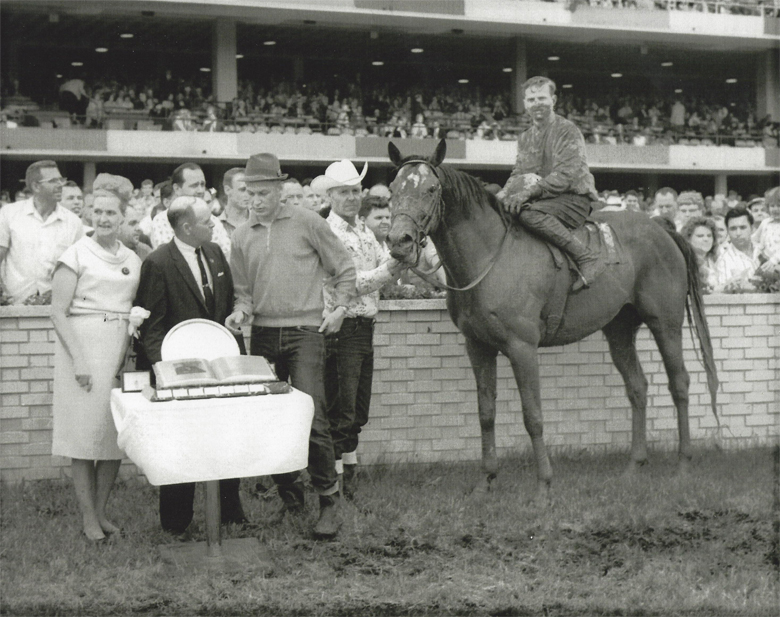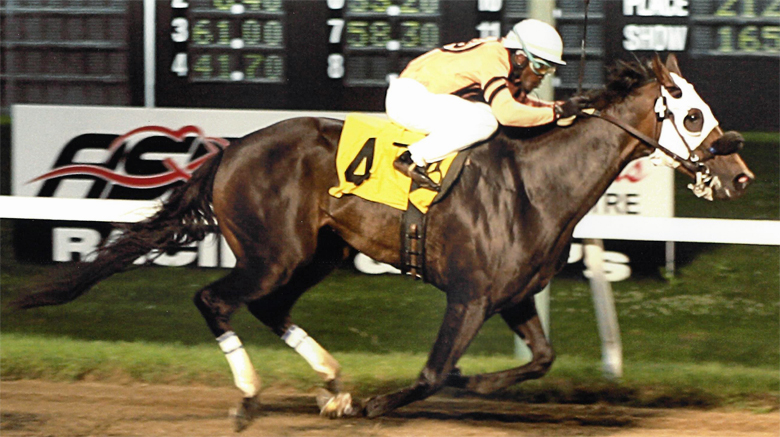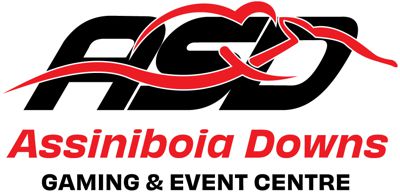
Mr. and Mrs. Jeffrey present R. J. Speers’ trophy to Gary Danelson. Cosmic Tip. Speers Handicap 1966.
by Bob Gates
Winnipeg native, Harry Jeffrey was in a word “Special.” He was fair, well-respected, and when called for, a no nonsense kind of guy. Jeffrey was also the first employee of Assiniboia Downs.
When Jack Hardy started looking for someone to “build” the racing surface for Assiniboia Downs, he chose Harry Jeffrey. It’s difficult to imagine, but there was nothing on the land that would become the Downs to help out the brand-spanking new Track Superintendent. The race track, and I’m not talking about the buildings, but rather the racing surface that would become the stage upon which thoroughbreds would perform, had to be created and Hardy needed someone he could trust to get the job done. When Jeffrey took the job in 1958 it was a post he would hold for life.
We celebrated the 60th season of racing this past Saturday night, and with June 10th being the anniversary of the local oval’s opening back in 1958, it seems only fitting to remember and honour Harry Sidney Jeffrey’s contributions to the Portage Avenue track.
Jeffrey got his start with horses in the mid 1930s as a jockey. He rode at Polo Park and Whittier Park, and those were no easy gigs. The field of runners back then was restricted to eight and there were anywhere from 30 to 40 riders clamoring for mounts. You had Johnny Longden, Don Meade, Johnny “Red” Pollard and George “The Ice Man” Woolf competing for work. The fact is, Harry didn’t get a lot of mounts and those he got weren’t the greatest.
After his riding career, Harry Jeffrey was an employee of Robert James Speers for a number of years. If you have any doubts as to Harry’s place in the hallowed hall of the local horse racing scene, he joined Duke Campbell and Scotty Kennedy as pallbearers at racing pioneer R. James Speers’ funeral in 1955.
 When it came to the Downs’ new race track, he knew the surface would have to stand the test of time. It needed a good base, one that would allow its competitors to run through all conditions. The key to Harry’s track was the 15″ limestone base. Once the foundation had been prepped, Harry had dirt from the track at old Whittier Park which held its last meet in 1942, vanned to the Downs.
When it came to the Downs’ new race track, he knew the surface would have to stand the test of time. It needed a good base, one that would allow its competitors to run through all conditions. The key to Harry’s track was the 15″ limestone base. Once the foundation had been prepped, Harry had dirt from the track at old Whittier Park which held its last meet in 1942, vanned to the Downs.
How do you measure the success of a racing surface? It’s durability! The first time a full day’s card was ever cancelled at Assiniboia Downs was July 6, 1977, almost four years after Harry’s death – now that’s saying something! His track met all challenges that the wicked Winnipeg weather gods could conjure.
It wasn’t unusual for Harry to put in an 18 hour-day. An early 5 a.m. start would often lead to an 11 p.m. curfew. He would often do double or triple duty as paddock judge and stall superintendent. Once racing was done he would travel with Scotty Kennedy promoting the Downs and scouting out new horsemen to ensure stalls would be filled to capacity.
These “shopping” expeditions were hugely successful. In 1964 the Downs turned away more than 300 horses because there wasn’t enough stall space. A late stall application usually meant you would not be racing at the Downs. How times have changed!
Around shed row Harry was known as “The Little Tiger.” When Harry Jeffrey wanted something done, it got done and done properly – or else, you’d hear the Little Tiger’s roar! Harry expected the same of the people who worked for him as he expected of himself, nothing but the best. If a job was worth doing, it was worth doing, well.
In addition to the race track, Harry made sure the roads in the stable areas were ship-shape. Harry was a proud man and he cared a great deal about his race track, every square inch of it. If a horseman didn’t keep his stable clean and presentable, he could expect a visit from Harry. If action was taken to rectify the situation, you’d be shown the door!
At the end of the season Harry would plant a crop of winter wheat on the track. Come spring just as the wheat was starting to show, he would till it under. This was his “cushion” and it served the track and the thoroughbreds well for many years.
In 1966 when the Downs introduced its inaugural harness meet, Harry Jeffrey was called upon to make the necessary changes to the race track, so it would be pleasing to the “jugheads.” The change over from flat to harness racing was always a busy time. In addition to readying the race track (harness horses run on a harder more packed surface), Jeffrey would see 600 runners vacate the barns to make way for 300-400 standardbreds.
In February 1971 the good folks with the Festival du Voyageur decided to resurrect horse racing at Whittier Park and run a harness meet, but they needed a racing surface. “Who you gonna call?” Of course they recruited Harry Jeffrey and like magic “poof,” it was done. This and in the dead of a brutal Winnipeg winter no less and there were no complaints from the horsemen about the track.
For the 1973 season the Downs created a “Director of Racing” position, and the man who got it all started in 1958 was promoted to the newly created post. His son, Harry Jr. who had been working with his father for the last 13 years was named as his replacement for the Track Superintendent position. As Director of Racing, Harry would work closely with Downs’ G.M. Bill Clubb in all aspects of the operation of the track, all the while serving as paddock judge, horse identifier and patrol judge.
Harry and his wife, Lilly had three sons, Harry Jr., Alex and Teddy and daughters, Lona and Cheryl. At some point they all worked at Assiniboia Downs.
Ted Jeffrey told me the story of a typical Christmas at the Jeffrey home back in the day. Over the years “A” barn was a winter home for a half-dozen or so horsemen, including old Bob Franklin who was a soft spoken black man from the States. Come the 25th of December, if the group had no place to go, they got invites to Christmas dinner at Harry and Lilly’s place.
The Jeffrey children learned quickly about the merits of hard work and good old fashion respect for adults. Ted explained his mother told him that he was to address Bob Franklin and the other adults by their sir names. It should be clear this was her rule, not Bobby Franklin’s. Franklin never insisted on being called Mr. Franklin, he was just plain “Bobby.” According to Teddy, it wasn’t until after his father passed that Bob Franklin sat him down and said that he meant no disrespect to Mrs. Jeffrey, but Ted was an adult now and it was “ok” to call him, Bobby. Some life-lessons last forever, don’t they?

Primary Factor wins the Harry Jeffrey Handicap on July 9, 2016.
On Thursday October 3, 1973 the heart of Assiniboia Downs stopped beating. Harry Jeffrey suffered a heart attack and passed, he was 55. In his honour the 1974 running of the Manitoba Derby prep-race, the St. James – Assiniboia Handicap was changed to the Harry Jeffrey Handicap. This year’s edition will mark the 43rd running of the race.
These days Bob Timlick has care and custody of Harry’s racing surface and guess who his assistant is? Harry’s son, Teddy! The major difference between today’s track and the one Harry created 60 years ago is its composition. The current track is 90% sand with the balance a clay/silt mix. Harry’s track was 60% sand and 40% clay and silt.
Ever tried to run on sand? It’s no wonder we haven’t seen a track record performance since 1992. The soft, cushiony sand provides for what is generally accepted as a good, safe track for our thoroughbred athletes.
All in all Assiniboia Downs should count its blessing having men like Keith Trenholm and Bob Timlick to watch over and nurture the baby that Harry fathered all those years ago.
Harry Jeffrey, the man with Assiniboia Downs in his veins is gone and the westend track had to find a way to go on, but it wasn’t easy. There are some things in life from which you never heal.
For Assiniboia Downs, the loss of the “Little Tiger” was one of them.
